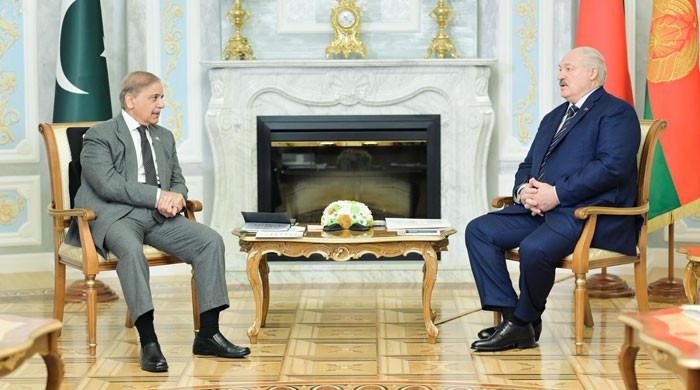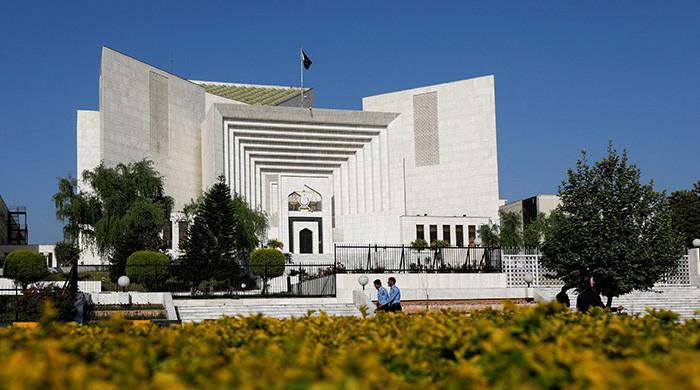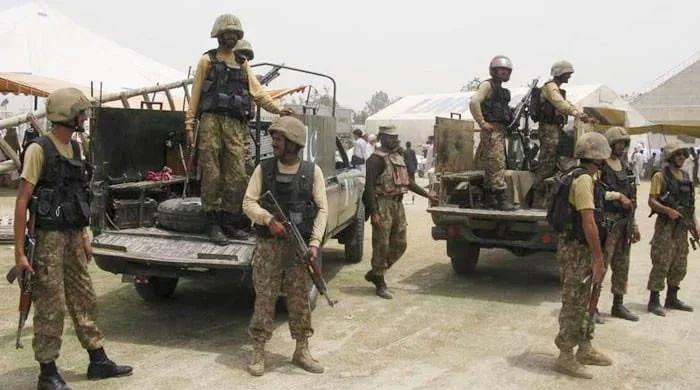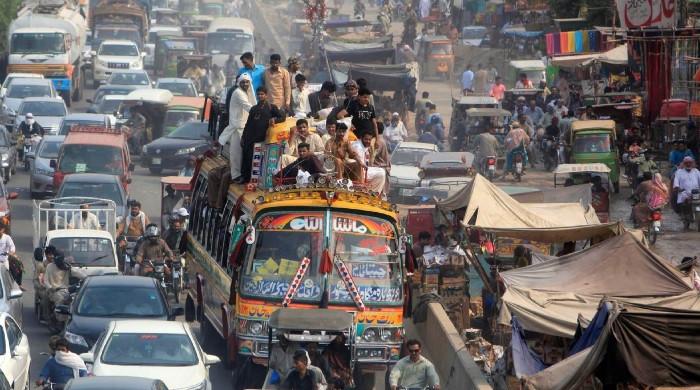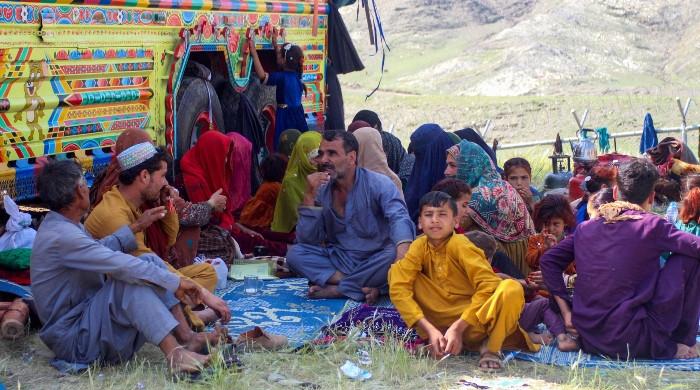The 31 conditions set by the Supreme Court on the Orange Line Metro Train project
The apex court has allowed the Punjab government to go ahead with the $1.6 billion project
December 08, 2017
ISLAMABAD: The Supreme Court ordered on Friday the continuation of work on the Orange Line Metro Train in Lahore, albeit with some conditions.
With a majority of four to one, the five-member bench hearing the appeal against the Lahore High Court decision partially stopping the project's construction around 11 historical sites ruled that the project will proceed subject to the following conditions and directions:
1) The appellant shall make all necessary arrangements to ensure that the monuments remain stable and undamaged in all respects during the execution of the Project as specified in the HIA and Study of Control of Vibration, Noise and Foundation;
2) Vibration monitoring shall be undertaken as a part of the monitoring plan using the crack measure devices such as Avongard Standard Tell-Tale throughout the construction period and for an additional period of 10 weeks from the date of commencement of commercial operation of the train or such further time as may be directed by the Director General, Archaeology.
In case, it is found that vibration levels at any stage of the construction or operation are exceeding safe limits, construction work/operation shall immediately be discontinued and remedial action shall be taken to ensure that such levels are brought down to acceptable limits. Such actions may inter alia include use of one piece of equipment at a time, during the construction phase, adjustment of train speed, addition of buffers and such other remedial and mitigating measures as may be recommended by the experts;
3) Technical experts shall be present at the sites during the construction phase in the vicinity of the antiquities and special premises with all necessary equipment for monitoring vibration levels. In case, vibration levels exceed the acceptable limits, work shall immediately be stopped, remedial measures taken to the satisfaction of experts and further work shall not commence unless written clearance for resumption of work is given by the experts;
4) An independent and experienced Conservation Engineer shall be appointed to monitor the Project, both during the construction and operation phases. He shall submit monthly reports to the Advisory Committee which shall Lahore Orange Line Metro Train Project 112 make such further recommendations to the Director General, Archaeology as may be required to ensure that the Project as a whole is meeting all technical requirements meant to preserve, protect and conserve the antiquities or protected premises;
5) On completion of the project, the train shall be operated on experimental basis for at least 2 weeks on the entire length of the route and the vibration levels shall be monitored to ensure that the same are within the acceptable limits.
Commercial operation shall not commence unless written clearance is given by the experts confirming that vibration levels have consistently been found to be within acceptable limits;
6) The speed of the Train shall be reduced while passing near the monuments as recommended by the Directorate General of Archaeology from time to time on the basis of data made available to it;
7) State of the art vibration measuring equipments shall permanently be installed at suitable places in and around the antiquities and special premises to monitor levels of vibration created by operation of the train. Records of the same shall be maintained and regularly checked by a responsible officer deputed to do so;
8) Special teams consisting of qualified experts will be set up which will periodically inspect all antiquities and special premises to detect any damage or deterioration at the sites. Proper records and logbooks shall be maintained for this purpose;
9) Any damage or deterioration shall be reported to the Director General, Archaeology in writing who shall take remedial steps necessary to ensure safety of the buildings and structures;
10) Recommendations of the Advisory Committee (already set up) shall be placed before the Directorate General of Archaeology, who shall take necessary steps to ensure that the same are complied with in letter and spirit by all concerned agencies, contractors, sub-contractors and operators;
11) Where excavation is necessary it shall be carried out in a way that it would not affect any structure or foundation of Lahore Orange Line Metro Train Project 113 the antiquities or special premises.
Where necessary special arrangements shall be made to stabilize and strengthen the structure of the antiquities and special premises. All necessary safety arrangements shall be made in accordance with the best engineering expertise during excavation, construction and execution phases of the Project;
12) The executing agency shall install accelerometers, velocity transducers, noise detectors and vibration measuring equipment near the antiquities and special premises. The appellant shall ensure implementation of additional mitigation and remedial measures as mentioned in vibration analysis report by NESPAK, Heritage Impact Assessment (HIA) as well as in the reports submitted by Dr Uppal and Dr Rogers;
13) Excavation would be carried out in a way that would not affect any of the exposed or buried structure of the Special Premises;
14) In case of any adverse impact to the antiquities or special premises during excavation, construction or execution, the appellant and all other related agencies shall immediately and forthwith stop and discontinue further work, take all possible actions to protect and conserve the antiquities and special premises and in this regard, involve such experts and consultants as may be necessary to ensure that the causes and effects of the adverse impact are effectively removed;
15) A dedicated hotline shall be set up, telephone numbers whereof shall be prominently displayed in public areas around all antiquities and special premises for reporting damage or deterioration observed by members of the public or tourists;
16) In case, any information/report is received by the Director General, Archaeology the same shall be investigated within 7 days and after receiving recommendations (if any) from experts repair/renovation work shall be commenced within 30 days;
17) No building material or equipment shall be stored/stockpiled within protected area of the monuments;
18) No change shall be made in the alignment of the track which brings any part of it nearer to the monuments than the distances set out hereinabove;
19) Dust pollution during construction shall be controlled through extensive sprinkling of water on regular basis and taking such other steps including but not limited to covering the monuments with protective sheets in order to avoid any damage from dust;
20) The design of the viaduct and nearby stations in terms of colour and designing shall be in harmony with the setting and appearance of the monuments;
21) The Hydraulic Tank of Shalamar Garden shall be restored, as far as possible, to its original position and the surrounding area will be converted into a green area;
22) Structures on the southern side of the Shalamar Garden shall be camouflaged through construction of a wall in consultation with the Directorate General of Archaeology.
All practicable efforts shall be made to create a Buffer Zone around Shalamar Garden as per proposal already pending in the Directorate General of Archaeology and other competent forums;
23) The decorative motifs of Shalamar Garden would be replicated on the train station near the Shalamar Garden to create harmony with the Garden;
24) The tile mosaic motifs of the Gulabi Bagh Gateway would be replicated on the nearby station of the Gateway to create harmony with the historic Gateway;
25) The area around the Chauburji Gateway would be properly attended and developed into a greenbelt;
26) The decorative motifs of the Chauburji Gateway would be replicated on the nearby station of the Chauburji Gateway to create a harmony with the historic Gateway;
27) The area around the Zaib-un-Nisa’s Tomb would be properly attended and developed;
28) The decorative motifs of the Zaib-un-Nisa’s Tomb would be replicated on the nearby station of the Zaib-un-Nisa’s Tomb to create harmony with the historic;
29) The Respondents shall in consultation with UNESCO and other international agencies prepare phase-wise plan to control and monitor urban encroachments and the process of creating buffer zone around the Shalamar garden;
30) All future projects which directly, indirectly and incidentally involve antiquities or heritage sites shall in the first instance be widely publicized through print and electronic media at least 6 months prior to proposed date of commencement of the project and public hearings shall be conducted to hear objections, if any against such project; and
31) For all future projects, NOCs, licences, approvals and permissions as required by law shall be obtained before work on the project site is commenced.







